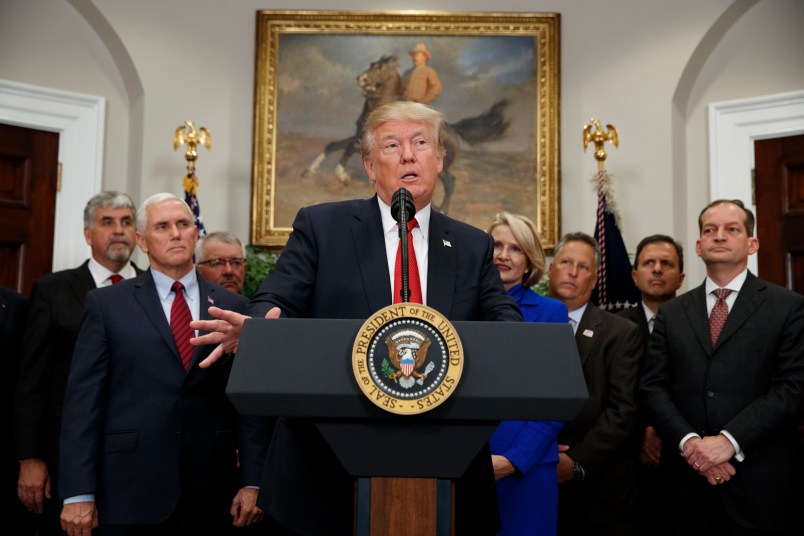President Trump signed an executive order Thursday taking aim at the Affordable Care Act, after Congress’ failure to pass a bill to repeal it.
The order is vague — it mainly directs certain agencies to relax a few key health care regulations imposed under President Obama — so it’s hard to assess its potential impact or the shape of the legal battle that will likely meet it. Its main goal appears to allow the purchase in certain scenarios of cheaper but more barebones plans, at the risk of diverting healthy people away from the more comprehensive policies mandated by the ACA and raising premiums for those reliant on the more generous plans.
Perhaps the most surprising thing about the order is that it does not go as far as Obamacare supporters had feared it could have in undermining the 2010 health care legislation.
The instructions the order gives the three relevant agencies — the Departments of Labor, Health and Human Services, and Treasury— directs them to seek three main areas of deregulation.
The first covers association health plans, in which employers can band together across trade groups or other shared interests to create their own risk pools and plan options. Before Obamacare, association health plans were tools for employers to set up plans in states with the loosest regulations.
The order Trump signed Thursday seeks to make it easier for employers to participate in association health plans by asking the three federal departments to consider relaxing some Employee Retirement Income Security Act regulations around these plans. Plans are exempted from some, but not at all of the Obamacare insurer mandates. For instance, they are exempted from the Essential Health Benefits, meaning these associations health plans can offer fewer coverage areas than the 10 mandated by the ACA.
Notably, the order only mentions employers’ access to association health plans. Reporting leading up to Thursday order suggested that it could also make it easier for individuals to participate in those plans, a move that stood to destabilize the individual market. This aspect of the executive order stands to mostly affect the small group market, assuming that the relevant departments don’t also go on to expand these plans to individuals as well.
The second regulation area the order covers is aimed at short-term limited duration insurance. Under Obama, individuals were only allowed to use this policies — which are also exempt from ACA mandates like Essential Health Benefits— for three months, for scenarios like when they were in between jobs.
“To the extent permitted by law and supported by sound policy, the Secretaries should consider allowing such insurance to cover longer periods and be renewed by the consumer,” Trump’s executive order said.
The third thrust of the order is to suggest an expansion of health savings accounts employees can use to pay for out-of-pocket health care expenses. Here, too, the details are sparse and it will largely be up to the agencies to work out the new regulations.
However the departments choose to respond to the order, they’ll have to go through a public comment period that it will take many more months. It’s also unclear what the agencies will do with the individual mandate and whether it will be waived for those using the skimpier plans encouraged by the order. That will greatly affect the eventual impact of Thursday’s order.
Read the order below:
EXECUTIVE ORDER
– – – – – – –
PROMOTING HEALTHCARE CHOICE AND
COMPETITION ACROSS THE UNITED STATES
By the authority vested in me as President by the Constitution and the laws of the United States of America, it is hereby ordered as follows:
Section 1. Policy. (a) It shall be the policy of the executive branch, to the extent consistent with law, to facilitate the purchase of insurance across State lines and the development and operation of a healthcare system that provides high-quality care at affordable prices for the American people. The Patient Protection and Affordable Care Act (PPACA), however, has severely limited the choice of healthcare options available to many Americans and has produced large premium increases in many State individual markets for health insurance. The average exchange premium in the 39 States that are usingwww.healthcare.gov in 2017 is more than double the average overall individual market premium recorded in 2013. The PPACA has also largely failed to provide meaningful choice or competition between insurers, resulting in one-third of America’s counties having only one insurer offering coverage on their applicable government-run exchange in 2017.
(b) Among the myriad areas where current regulations limit choice and competition, my Administration will prioritize three areas for improvement in the near term: association health plans (AHPs), short-term, limited-duration insurance (STLDI), and health reimbursement arrangements (HRAs).
(i) Large employers often are able to obtain better terms on health insurance for their employees than small employers because of their larger pools of insurable individuals across which they can spread risk and administrative costs. Expanding access to AHPs can help small businesses overcome this competitive disadvantage by allowing them to group together to self-insure or purchase large group health insurance. Expanding access to AHPs will also allow more small businesses to avoid many of the PPACA’s costly requirements. Expanding access to AHPs would provide more affordable health insurance options to many Americans, including hourly wage earners, farmers, and the employees of small businesses and entrepreneurs that fuel economic growth.
(ii) STLDI is exempt from the onerous and expensive insurance mandates and regulations included in title I of the PPACA. This can make it an appealing and affordable alternative to government-run exchanges for many people without coverage available to them through their workplaces. The previous administration took steps to restrict access to this market by reducing the allowable coverage period from less than 12 months to less than 3 months and by preventing any extensions selected by the policyholder beyond 3 months of total coverage.
(iii) HRAs are tax-advantaged, account-based arrangements that employers can establish for employees to give employees more flexibility and choices regarding their healthcare. Expanding the flexibility and use of HRAs would provide many Americans, including employees who work at small businesses, with more options for financing their healthcare.
(c) My Administration will also continue to focus on promoting competition in healthcare markets and limiting excessive consolidation throughout the healthcare system. To the extent consistent with law, government rules and guidelines affecting the United States healthcare system should:
(i) expand the availability of and access to alternatives to expensive, mandate-laden PPACA insurance, including AHPs, STLDI, and HRAs;
(ii) re-inject competition into healthcare markets by lowering barriers to entry, limiting excessive consolidation, and preventing abuses of market power; and
(iii) improve access to and the quality of information that Americans need to make informed healthcare decisions, including data about healthcare prices and outcomes, while minimizing reporting burdens on affected plans, providers, or payers.
Sec. 2. Expanded Access to Association Health Plans. Within 60 days of the date of this order, the Secretary of Labor shall consider proposing regulations or revising guidance, consistent with law, to expand access to health coverage by allowing more employers to form AHPs. To the extent permitted by law and supported by sound policy, the Secretary should consider expanding the conditions that satisfy the commonality‑of-interest requirements under current Department of Labor advisory opinions interpreting the definition of an “employer” under section 3(5) of the Employee Retirement Income Security Act of 1974. The Secretary of Labor should also consider ways to promote AHP formation on the basis of common geography or industry.
Sec. 3. Expanded Availability of Short-Term, Limited‑Duration Insurance. Within 60 days of the date of this order, the Secretaries of the Treasury, Labor, and Health and Human Services shall consider proposing regulations or revising guidance, consistent with law, to expand the availability of STLDI. To the extent permitted by law and supported by sound policy, the Secretaries should consider allowing such insurance to cover longer periods and be renewed by the consumer.
Sec. 4. Expanded Availability and Permitted Use of Health Reimbursement Arrangements. Within 120 days of the date of this order, the Secretaries of the Treasury, Labor, and Health and Human Services shall consider proposing regulations or revising guidance, to the extent permitted by law and supported by sound policy, to increase the usability of HRAs, to expand employers’ ability to offer HRAs to their employees, and to allow HRAs to be used in conjunction with nongroup coverage.
Sec. 5. Public Comment. The Secretaries shall consider and evaluate public comments on any regulations proposed under sections 2 through 4 of this order.
Sec. 6. Reports. Within 180 days of the date of this order, and every 2 years thereafter, the Secretary of Health and Human Services, in consultation with the Secretaries of the Treasury and Labor and the Federal Trade Commission, shall provide a report to the President that:
(a) details the extent to which existing State and Federal laws, regulations, guidance, requirements, and policies fail to conform to the policies set forth in section 1 of this order; and
(b) identifies actions that States or the Federal Government could take in furtherance of the policies set forth in section 1 of this order.
Sec. 7. General Provisions. (a) Nothing in this order shall be construed to impair or otherwise affect:
(i) the authority granted by law to an executive department or agency, or the head thereof; or
(ii) the functions of the Director of the Office of Management and Budget relating to budgetary, administrative, or legislative proposals.
(b) This order shall be implemented consistent with applicable law and subject to the availability of appropriations.
(c) This order is not intended to, and does not, create any right or benefit, substantive or procedural, enforceable at law or in equity by any party against the United States, its departments, agencies, or entities, its officers, employees, or agents, or any other person.
DONALD J. TRUMP
THE WHITE HOUSE,
October 12, 2017.










